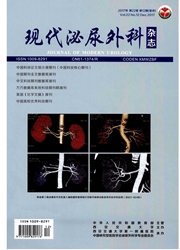

 中文摘要:
中文摘要:
目的分析新型可视前列腺症状评分(VPSS)与国际前列腺症状评分(IPSS)及最大尿流率(Qmax)的相关性,评估VPSS对良性前列腺增生症(BPH)症状严重程度及临床应用的价值。方法门诊选取274位良性前列腺增生症患者进行IPSS和VPSS评分,VPSS包括Q1(尿频)、Q2(夜尿)、Q3(尿线症状)和Q4(生活质量)4个问题,分别统计每个问题的得分及总分,并测量患者最大尿流率(Qmax)和平均尿流率(Qave),运用χ2检验、Spearman相关性分析、LSD多重检验、SNK检验及Mantel-Haenszel检验等进行统计学分析。结果完成VPSS评分用时显著少于IPSS评分(84svs.187s,P〈0.001),VPSS总分、Q3、Q4与Qmax之间存在明显的负相关(r=-0.552,P〈0.000 1;r=-0.633,P〈0.000 1;r=-0.553,P〈0.000 1);Q3、Q4与VPSS总分之间存在明显的正相关(r=0.716,P〈0.000 1;r=0.799,P〈0.000 1)。Q3的分组中,各组间存在显著性差异(P〈0.000 1);Qmax≤15mL/s的百分率明显与VPSS Q3得分呈线性递增关系。结论 VPSS与IPSS、Qmax间存在明显相关性,而在良性前列腺增生症患者的下尿路症状评估中,VPSS较IPSS更适合不同教育程度的患者,尤其是受教育程度及读写能力较低的患者。
 英文摘要:
英文摘要:
Objective To evaluate the correlation between visual prostate symptom score(VPSS),international prostate symptom score(IPSS)and uroflowmetry parameters,and to assess the significance of VPSS in diagnosing benign prostatic hyperplasia(BPH).Methods The IPSS,VPSS,uroflowmetry parameters(Qmax and Qave)of 274 BPH cases were evaluated.Four VPSS questions related to urinary frequency(Q1),nocturia(Q2),urinary stream(Q3),and quality of life(QoL,Q4)had been scored.The Chi-square test,Spearman correlation test,Least-Significant Difference(LSD),Student-Newman-Keuls(SNK)and Mantel-Haenszel test were used to evaluate the relationship between VPSS,IPSS and Qmax.Results The time taken to complete the VPSS vs.IPSS was significantly shorter(84 vs.187 seconds,P〈0.001).There were significant positive correlations between the VPSS and Q3(r=0.716,P〈0.000 1),VPSS and Q4(r=0.799,P〈0.000 1),Q3 and Q4(r=0.680,P〈0.000 1),while there were significant negative correlation between VPSS,Q3,Q4,and Qmax respectively(r=-0.552,P0.000 1;r=-0.633,P〈0.0001;r=-0.553,P〈0.000 1).Additionally,there was a significant increase in the ratio of the maximal flow rate15 mL/s to VPSS obstructive symptoms(Q3)as the severity of VPSS obstructive symptoms increased(P〈0.000 1).Conclusion The VPSS correlates significantly with IPSS and Qmax.It can be used to substitute IPSS to estimate low urinary tract symptoms in BPH patients with limited education.
 同期刊论文项目
同期刊论文项目
 同项目期刊论文
同项目期刊论文
 期刊信息
期刊信息
